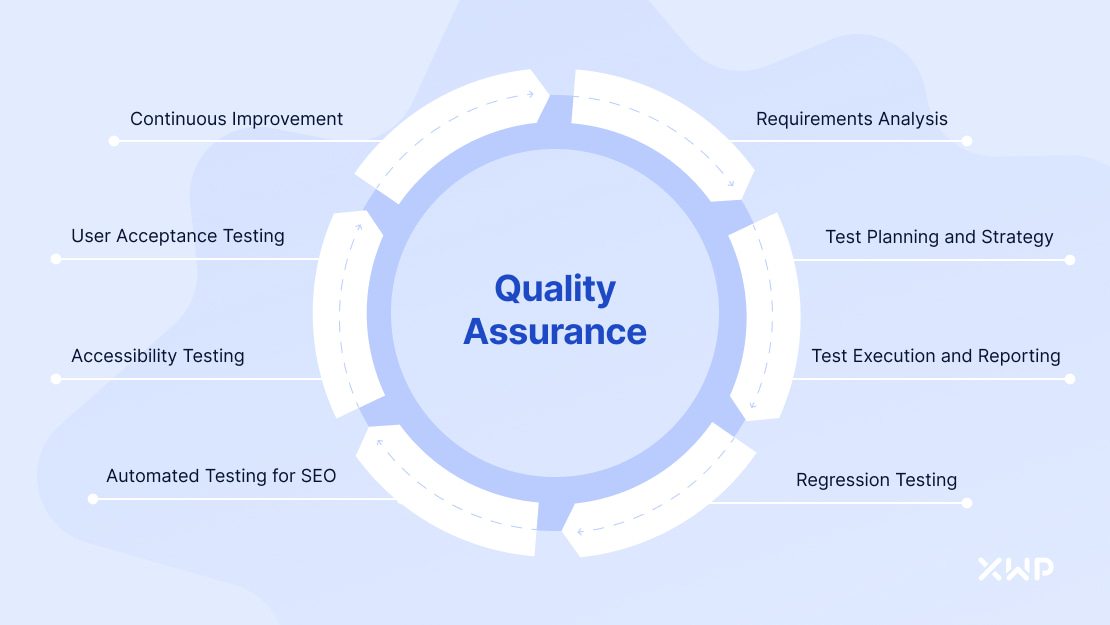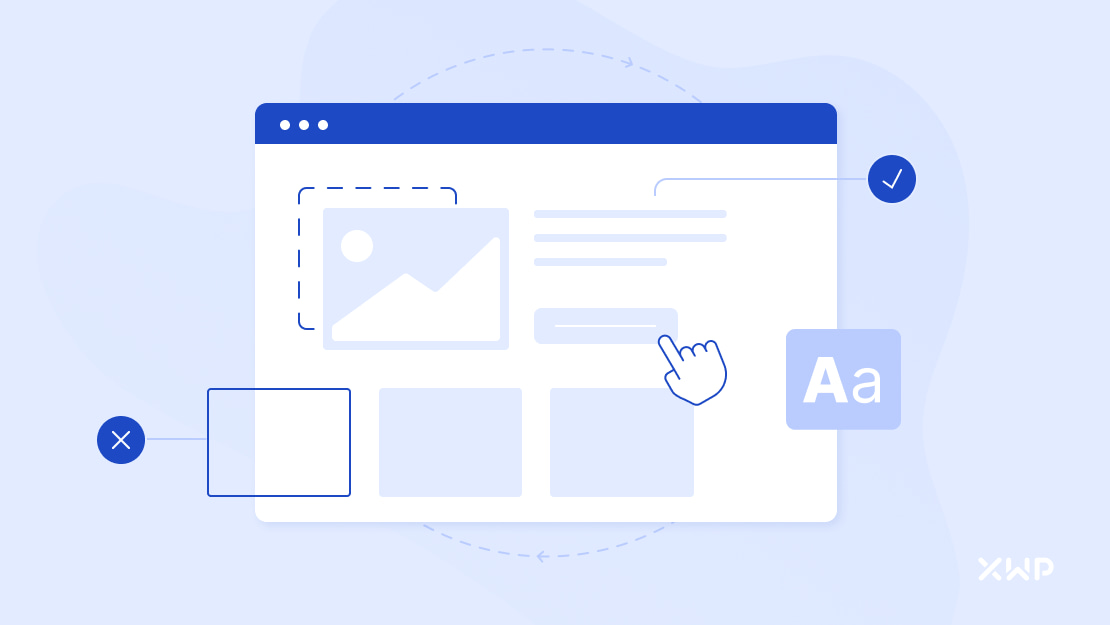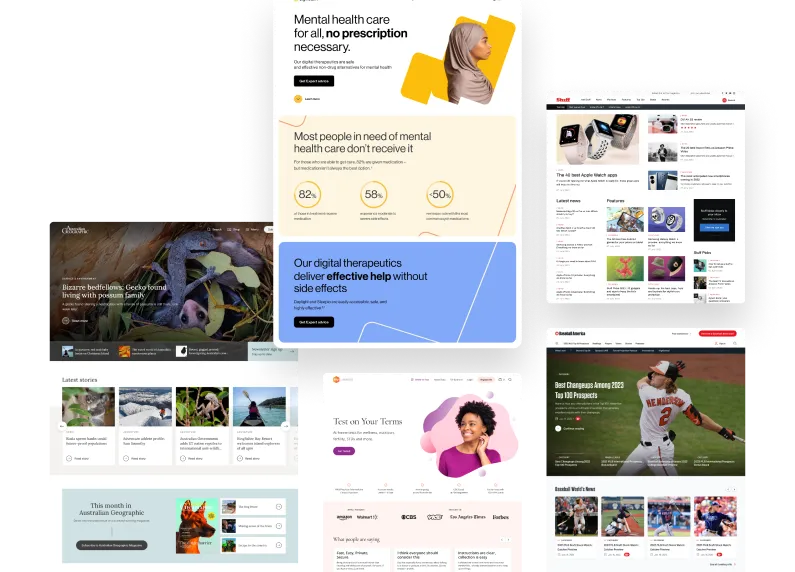"At XWP, we view QA as more than just a box-ticking exercise; it’s a strategic focus that drives the delivery of high-quality, performant websites."
There’s a common misconception that Quality Assurance is something that happens at the end of a project. In reality, QA permeates every stage of the development lifecycle, from Discovery to Delivery (and in many cases, beyond!) ensuring that websites meet client requirements and industry standards.
At XWP, we view QA as more than just a box-ticking exercise; it’s a strategic focus that drives the delivery of high-quality, performant websites. By integrating QA practices into our development workflows from the outset, we mitigate risks, streamline processes, and ultimately deliver better digital solutions to our clients.

Key Components of Quality Assurance:
Every agency will have its own approach to QA, but at XWP we pride ourselves on our comprehensive multi-tiered approach to creating quality solutions. Let’s take a look at some of the QA measures we have in place for our clients:
Requirements Analysis:
The QA process begins in Discovery, with a thorough analysis of client requirements, project specifications, and stakeholder expectations. With a deep understanding of the project scope, objectives, and success criteria, our specialized Quality Assurance team lays the foundation for effective testing strategies and ensures alignment with client goals.
During this phase, our QA team collaborates closely with project managers, developers, and designers to clarify ambiguities, identify potential challenges, and establish clear acceptance criteria. This proactive approach helps prevent misunderstandings and ensures that everyone involved in the project shares a common outlook on deliverables and expectations.

Test Planning and Strategy
Once project requirements are defined, our QA team develops comprehensive test plans and strategies tailored to the specific needs of each project. Test planning involves identifying test scenarios, defining test cases, and determining the appropriate testing methodologies based on factors such as project complexity, timeline, and budget.
At XWP, we employ a combination of manual and automated testing techniques to achieve optimal test coverage and efficiency. Automated testing tools help accelerate repetitive tasks and ensure consistency in test execution, while manual testing allows for exploratory testing, usability evaluation, and edge case analysis.
Test Execution and Reporting
With test plans in place, the QA team proceeds to execute test cases, verify functionalities, and identify defects or inconsistencies in the website’s behavior throughout development. Test execution involves rigorous testing of individual features, integrations, and workflows to ensure they meet predefined acceptance criteria and performance benchmarks.
Throughout the test execution phase, our QA specialists meticulously document test results, including defects, issues, and observations, in comprehensive test reports. These reports provide stakeholders with visibility into the QA process, enabling informed decision-making and facilitating communication between project teams.

Regression Testing
Regression testing is a critical phase in the QA process that focuses on verifying that new code changes or updates have not adversely affected existing functionalities or introduced unexpected bugs. At XWP, we highly value the importance of regression testing in maintaining the stability and integrity of websites, especially in complex and dynamic digital environments.
During regression testing, our QA team thoroughly examines all aspects of the website, including features, functionalities, integrations, and performance metrics. We leverage automated testing tools, as well as manual testing processes, to ensure comprehensive coverage and accuracy in identifying potential regressions.
One of the key challenges in regression testing is balancing thoroughness with efficiency, especially in large-scale web development projects. At XWP, we employ a risk-based approach to regression testing, prioritizing critical functionalities and high-impact areas based on factors such as business impact, frequency of use, and complexity.
Our QA team collaborates closely with developers, project managers, and stakeholders to define regression testing strategies tailored to each project’s unique requirements. By continuously monitoring and adapting our testing approach, we mitigate risks, streamline workflows, and accelerate the delivery of high-quality websites to our clients.

Automated Testing for Search Engine Optimization
Search Engine Optimization (SEO) is critical for driving organic traffic to websites and maximizing their visibility in search engine results pages (SERPs). Any unexpected changes to metadata, structured data, or other SEO elements can have a significant financial impact, affecting ad revenue and jeopardizing the website’s competitive position in search rankings.
To mitigate these risks, our QA team utilizes automated testing tools and scripts to continuously monitor SEO-related elements throughout the development lifecycle. This proactive approach allows us to detect and address issues promptly, ensuring that websites maintain optimal performance and visibility in search engine results.
Accessibility Testing
Accessibility testing is an essential component of our Quality Assurance process at XWP, ensuring that websites are inclusive and accessible to users of all abilities.
Accessibility testing involves evaluating websites against accessibility guidelines such as the Web Content Accessibility Guidelines (WCAG), identifying potential barriers to access, and implementing remediation strategies to address any issues found.
Our QA team collaborates with developers and designers to integrate accessibility best practices into the entire development process, fostering a culture of inclusivity and ensuring that websites are easily usable by everyone— regardless of their physical or cognitive abilities.

User Acceptance Testing (UAT)
User acceptance testing (UAT) is the final phase in the QA process, where the website undergoes validation by end-users or stakeholders to ensure alignment with their expectations and requirements. At XWP, we view UAT as a crucial opportunity to gather feedback, verify functionalities, and refine the user experience based on real-world usage scenarios.
During UAT, clients are actively involved in testing the website’s features, functionalities, and overall usability. Our QA team collaborates closely with clients to define test cases, establish acceptance criteria, and facilitate user testing sessions.
By soliciting feedback directly from end-users, we gain valuable insights into their preferences, pain points, and expectations, enabling us to fine-tune the website to meet their needs effectively before a public launch.
Continuous Improvement (CI)
At XWP, we are committed to a culture of continuous improvement, where we leverage feedback, data, and insights to refine our QA processes and enhance the quality of our deliverables. For our Orbiter clients, our project team conducts regular retrospectives to review project outcomes, identify areas for improvement, and implement corrective actions to optimize our workflows and methodologies.
Additionally, XWP invests in ongoing training and tooling for QA team members to stay abreast of the latest trends, technologies, and best practices in web development and quality assurance. By fostering a culture of learning and innovation, we empower our team to drive excellence in QA and deliver exceptional digital experiences to our clients consistently.

Conclusion
Quality Assurance plays a pivotal role in web development, ensuring that websites are functional, performant, and user-friendly. At XWP, we prioritize QA as an integral part of our development process, leveraging advanced tools, methodologies, and best practices to deliver exceptional digital experiences to our clients. Through continuous improvement and a commitment to excellence, we empower businesses to thrive in the digital landscape and achieve their goals with confidence.


